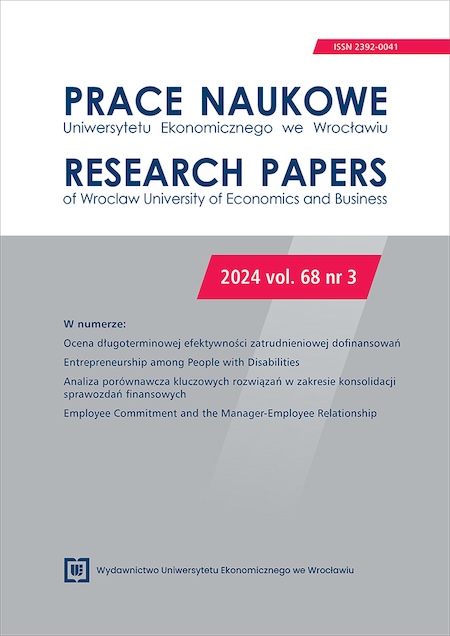Internal Loans of the Second Polish Republic
Keywords:
internal loans, effectiveness of loans, Second Polish RepublicAbstract
Aim: The aim of the article is a short analysis of the internal loans taken out by the Polish state in the first post-war years of its existence. Attempts were made to present the nature of those loans, the effectiveness of their collection and the effects on the economy.
Methodology: The following methods were used: source analysis, comparative analysis and description. Based on source materials, including official forms, the loans taken were systematized. The comparative analysis method allowed us to look for similarities and differences between them and their impact on the economy. A simple method of description was used to present their size and effectiveness.
Results: An assessment of the importance of internal loans for the economy until the mid-1920s leads to the conclusion that the “Asygnaty” loan had the greatest social response, but the results of all loans were clearly weakened by inflation. Moreover, at the beginning, the public eagerly bought bonds to support the rebuilding economy. In the following years, its possibilities were exhausted, inflation was rising, and the rich industrial and landed gentry were not eager to buy bonds, believing that they had to pay increasing taxes anyway.
Implications and recommendations: When issuing loans, the government should have taken into account the financial condition of Polish society, inflation and the fact that the richest people, despite loud declarations of patriotism, were not willing to purchase bonds. For the most part, those loans drained the pockets of the rest of society. Despite the planned forced loan, it was not decided to implement it for fear of reaction. The topic of internal loans awaits detailed study.
Originality/value: There are few works that only fragmentarily describe the taking out of internal loans in connection with broader research on the finances of the Second Polish Republic. This text presents in chronological terms the loans that the Polish state took out on the internal market from regaining independence until the mid-1920s, organizing information about them in one article.
Downloads
References
Drozdowski, M. (1963). Polityka gospodarcza rządu polskiego 1936-1939. PWN.
Dziennik Praw Państwa Polskiego (DPPP) z 1919 r. Nr 23, poz. 236; z 1920 r. Nr 38, poz. 221.
Dziennik Ustaw Rzeczypospolitej Polskiej (DURP) z 1920 r. Nr 25, poz. 152; z 1920 r. Nr 67; z 1922 r. Nr 1; z 1922 r. Nr 83; z 1922 r. Nr 23; z 1923 r. Nr 12; z 1923 r. Nr 33; z 1924 r. Nr 55; z 1949 r. Nr 45.
Grabski, W. (1927). Dwa lata pracy u podstaw państwowości naszej (1924-1925). Księgarnia F. Hoesicka.
Gradowski, R. (1959). Polska 1918-1939. Niektóre zagadnienia kapitalizmu monopolistycznego. Książka i Wiedza.
Karpiński, Z. (1920). Dotychczasowy przebieg tzw. reformy walutowej. Przegląd Gospodarczy, (2), 4-7.
Karpiński, Z. (1958). Bank Polski 1924-1939. Przyczynek do historii gospodarczej okresu międzywojennego. Polskie Wydawnictwa Gospodarcze.
Karpiński, Z. (1968). Ustroje pieniężne w Polsce od roku 1917. PWN.
Klarner, C. (1939). Długi państwowe Polski. Drukarnia Techniczna.
Krzyżanowski, A. (1923). Nauka skarbowości. Wydawnictwo Fiszer i Majewski.
Krzyżanowski, A. (1931). Polityka i gospodarstwo. Pisma pomniejsze oraz przemówienia 1920-1931. Nakładem PAU.
Kwiatkowski, E. (1929). Istotne założenia w walce o nowy ustrój (odczyt wygłoszony we Lwowie 1.12.1929 r.). Księgarnia F. Hoesicka.
Kwiatkowski, E. (1935). W walce z teraźniejszością o lepszą przyszłość gospodarczą. Przemówienie na Plenum Sejmu w dniu 5.12.1935 r. Nakładem Tygodnika „Polska Gospodarcza”.
Landau, Z. i Tomaszewski, J. (1967). Gospodarka Polski międzywojennej. Tom I: W dobie inflacji (1918-1923). Książka i Wiedza.
Młynarski, F. (1971). Wspomnienia. PWN.
Monitor Polski. (1920). 109.
Ostrowski, K. (1958). Polityka finansowa Polski przedwrześniowej. PWN.
Podwiński, R. (1920). Polska pożyczka państwowa. Tygodnik Bialski, (19).
Pożyczka Odrodzenia Polski. (1920). Pobrano 23 maja 2024 z https://1920.gov.pl/plakat/pozyczka-odrodzenia-polski-dobosz/
Rose, E. (1920, 15 kwietnia). Wspólny obowiązek i wspólny interes. Przegląd Gospodarczy, (2), 1-4.
Seeliger, J. (1937). Pożyczki Państwowe Polski. Drukarnia Przemysłowa.
Starzyński, S. (1928). Myśl państwowa w życiu gospodarczym. W: S. Starzyński (red.), Na froncie gospodarczym. W dziesiątą rocznicę odzyskania niepodległości 1918 11 XI 1928 (s. 1-22). Wydawnictwo „Drogi”.
Strasburger, E. (1920). Finanse Rzeczypospolitej Polskiej 1919-1920. Ekonomista, (III), 29-56.
Szturm de Sztrem, T. (1923). Żywiołowość w opodatkowaniu: podatek inflacyjny. Instytut Gospodarstwa Społecznego, Warszawa.
Taylor, E. (1926). Inflacja polska. Poznańskie Towarzystwo Przyjaciół Nauk.
Tygodnik Bialski (1920, 8 maja). 19.
Wierzbicki, A. (1920). W sprawie pożyczki przymusowej. Przegląd Gospodarczy, 1.11(15), 7-12.
Zasady pożyczki przymusowej. (1920, 1 listopada). Przegląd Gospodarczy, (15), 12-15.
Zdziechowski, J. (1937). Mit złotej waluty. Instytut Wydawniczy „Biblioteka Polska”.
Downloads
Published
Issue
Section
Categories
License
Copyright (c) 2024 Urszula Zagóra-Jonszta

This work is licensed under a Creative Commons Attribution-ShareAlike 4.0 International License.
Accepted 2024-08-08
Published 2024-09-24









